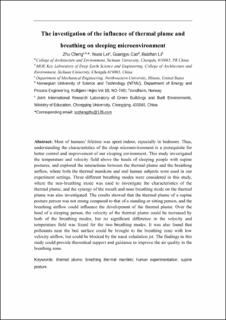| dc.description.abstract | Most of humans’ lifetime was spent indoor, especially in bedroom. Thus, understanding the characteristics of the sleep microenvironment is a prerequisite for better control and improvement of our sleeping environment. This study investigated the temperature and velocity field above the heads of sleeping people with supine postures, and explored the interactions between the thermal plume and the breathing airflow, where both the thermal manikins and real human subjects were used in our experiment settings. Three different breathing modes were considered in this study, where the non-breathing mode was used to investigate the characteristics of the thermal plume, and the synergy of the mouth and nose breathing mode on the thermal plume was also investigated. The results showed that the thermal plume of a supine posture person was not strong compared to that of a standing or sitting person, and the breathing airflow could influence the development of the thermal plume. Over the head of a sleeping person, the velocity of the thermal plume could be increased by both of the breathing modes, but no significant difference in the velocity and temperature field was found for the two breathing modes. It was also found that pollutants near the bed surface could be brought to the breathing zone with low velocity airflow, but could be blocked by the nasal exhalation jet. The findings in this study could provide theoretical support and guidance to improve the air quality in the breathing zone. | en_US |
